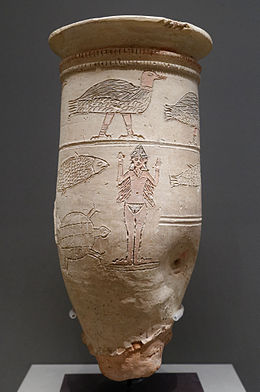
Back Tempelprostitusie Afrikaans دعارة مقدسة Arabic পবিত্র পতিতাবৃত্তি Bengali/Bangla Prostitució sagrada Catalan Chrámová prostituce Czech Tempelprostitution Danish Tempelprostitution German Ιερή πορνεία Greek Prostitución sagrada Spanish Prostituzio sakratu Basque

Sacred prostitution, temple prostitution, cult prostitution,[1] and religious prostitution are purported rites consisting of paid intercourse performed in the context of religious worship, possibly as a form of fertility rite or divine marriage (hieros gamos). Scholars prefer the terms "sacred sex" or "sacred sexual rites" in cases where payment for services is not involved.
The historicity of literal sacred prostitution, particularly in some places and periods, is a controversial topic within the academic world.[2] Historically mainstream historiography has considered it a probable reality, based on the abundance of ancient sources and chroniclers detailing its practices,[1][3] although it has proved harder to differentiate between true prostitution and sacred sex without remuneration.[4] Beginning in the late 20th century, a number of scholars have challenged the veracity of sacred prostitution as a concept, suggesting that the claims are based on mistranslations, misunderstandings or outright inventions of ancient authors.[5][3][6][7] Authors have also interpreted evidence as secular prostitution administered in the temple under the patronage of fertility deities, not as an act of religious worship by itself.[8][9]
- ^ a b Schulz, Matthias (26 March 2010). "Sex in the Service of Aphrodite: Did Prostitution Really Exist in the Temples of Antiquity?". Der Spiegel. Archived from the original on 26 November 2018. Retrieved 1 January 2016.
- ^ Cooper 1971, pp. 18–19.
- ^ a b Stol 2016, pp. 419–435.
- ^ Joan Goodnick Westenholz, Tamar, Qedesha, Qadishtu, and Sacred Prostitution in Mesopotamia, The Harvard Theological Review 82, 198
- ^ Beard, Mary; Henderson, John (November 1997). "With This Body I Thee Worship: Sacred Prostitution in Antiquity". Gender & History. 9 (3): 480–503. doi:10.1111/1468-0424.00072. ISSN 0953-5233.
- ^ Cite error: The named reference
Budin3was invoked but never defined (see the help page). - ^ Larson, Paul (2010), "Sacred Prostitution", in Leeming, David A.; Madden, Kathryn; Marlan, Stanton (eds.), Encyclopedia of Psychology and Religion, Boston, MA: Springer US, pp. 804–805, doi:10.1007/978-0-387-71802-6_600, ISBN 978-0-387-71801-9, retrieved 16 March 2024
- ^ Martin Gruber, Hebrew Qedesha and her Canaanite and Akkadian Cognates, Ugarit-Forschungen 18, 1986
- ^ Gerda Lerner, The Origin of Prostitution in Ancient Mesopotamia, Signs 11, 1986